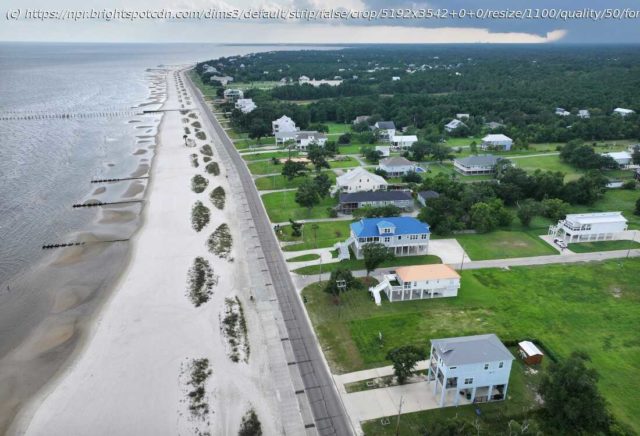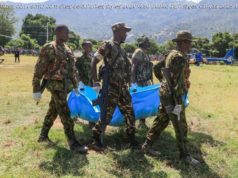While much of the focus marking 20 years since Hurricane Katrina is on New Orleans, where federal levees failed and flooded the city, the historic storm also decimated the Mississippi Gulf Coast.
Former Mississippi Gov. Haley Barbour stands before a wall-sized satellite image of Hurricane Katrina as it headed for landfall on Aug. 29, 2005.
« The eye came in right there over the Pearl River, which is the boundary between Louisiana and Mississippi », he says.
It was packing winds of 120 miles an hour and a storm surge nearing 30 feet. « The most powerful winds, and storm surge are in the upper right-hand corner. And that hit us », Barbour recalls.
Barbour is walking through a new exhibit at the state-funded Two Mississippi Museums in Jackson. It’s called Hurricane Katrina: Mississippi Remembers and features photographs of the aftermath by Melody Golding.
While much of the focus marking 20 years since Hurricane Katrina is on New Orleans, where federal levees failed and flooded the city, the historic storm also decimated the Mississippi Gulf Coast.
The state’s entire 70-mile shoreline was inundated with Katrina’s three-story-high storm surge. It knocked out bridges, buckled roads, and washed away homes and businesses. The storm killed 238 people in Mississippi and nearly 1,400 overall.
« It looked like the hand of God had wiped away the coast », Barbour recalls. « Utter obliteration. »
He says some 60,000 structures were uninhabitable, and more than 25,000 were flat out gone. « We created a new verb », he says. « I’ve been slabbed. » As in, there’s nothing left of my house but the concrete slab it was built on. Coastal flooding reached 10 miles inland, and hurricane-force winds stretched well into north Mississippi.
Barbour was in his first term as governor of Mississippi, back home after years as a Republican power broker in Washington, D.C., including serving as political director in the Reagan White House, and chairman of the Republican National Committee.
The first crisis after Katrina hit came immediately when he realized that federal aid was not on the way. The Federal Emergency Management Agency was overwhelmed and couldn’t rush food and water to the Gulf Coast. « From almost the beginning, the logistical plan collapsed », Barbour says. « And we weren’t getting what we’re supposed to be getting. »
The state turned to the military — the United States Northern Command — for help. The unit flew Army rations to Biloxi. After the initial bumps, though, Barbour says the federal response improved and the state got help, including reimbursement for cleaning up debris, an endeavor that took a year and a half. Barbour says Mississippi needed FEMA to begin the road to recovery.
« It would have been very, very hard to do without FEMA », he says, skeptical of the Trump administration’s talk of eliminating the agency. « Could you organize it in a different way? Maybe. But to have no federal disaster assistance program would be a catastrophe. Often. »
Barbour says major disasters require lots of outside help. For instance, 48 other states came to the rescue in Mississippi, sending National Guard units, law enforcement officers, and road and power crews. Some left their vehicles behind as replacements for the local police whose fleets were flooded out.
But more than $5 billion in federal grants were key, Barbour says. It didn’t hurt that Mississippi Republican Thad Cochran was the powerful chairman of the Senate Appropriations Committee at the time. Barbour says he also found allies across the political aisle — Massachusetts Democrat Barney Frank offered to corral votes in the House for Mississippi relief.
Barbour’s approach to Mississippi’s recovery was to focus on bringing back jobs, schools, and most important, housing to get people to return to the coast.
The rebuilding effort got a huge boost from the more than 900,000 volunteers who came to help rebuild Mississippi in the five years after Katrina.
Home
United States
USA — Events The long recovery on the Mississippi Gulf Coast, 'ground zero' for Hurricane...






